Weekly Current Affairs (22nd to 31st January 2025) | General Test Preparation for CUET UG - CUET Commerce PDF Download
Challenges Related to Aging Population
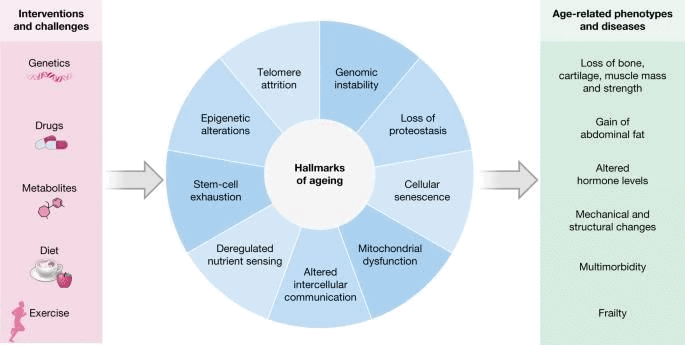 Why in News?
Why in News?
- The Supreme Court of India refused to entertain a writ petition that sought the establishment of a dedicated Ministry for senior citizens. The writ petition referred to population aging as a vulnerable class that deserves special attention under Article 21 of the Constitution, which ensures the right to a dignified life.
Key Takeaways
- India's elderly population (60+) is projected to grow significantly, reaching 20.8% by 2050.
- The elderly population will outnumber children by 2046, with a decline in the working-age group by 2050.
- By 2021, the aging index in India was 39, indicating a higher number of elderly persons relative to children.
Additional Details
- Status of Senior Citizens in India: India’s elderly population is increasing rapidly, with projections indicating it will exceed 36% by 2100. The decadal growth rate of the elderly population increased from 31% (1981–1991) to 41% (2021–2031).
- Old-Age Dependency Ratio: In 2021, there were 16 elderly individuals per 100 working-age persons, varying across regions.
- Life Expectancy: The average life expectancy at 60 years in India is 18.3 years, with females living longer than males.
- Regional Comparisons: By 2050, SAARC countries will have an average elderly population of 19.8%, with India’s share projected to be around 20%.
Challenges with the Aging Population
- Feminization of Aging: More elderly women than men, leading to increased vulnerability.
- Ruralization of Aging: Approximately 71% of the elderly live in rural areas, facing limited access to healthcare and social services.
- Aging of the Aged: A growing proportion of the elderly will be 75+, increasing the demand for healthcare and caregiving.
- Economic Dependency: Many elderly individuals lack pensions and face financial insecurity.
- Lack of Geriatric Care Facilities: Significant percentages of elderly individuals suffer from chronic conditions, affecting their daily activities.
- Employability Challenges: Senior citizens encounter age discrimination and outdated skills, limiting job opportunities.
- Social and Family Abuse: Seniors are at risk of verbal abuse and physical harm, often going unreported.
Major Elderly Care Schemes in India
- Atal Vayo Abhyudaya Yojana
- Rashtriya Vayoshri Yojana (RVY)
- National Social Assistance Programme (NSAP)
- National Programme for the Health Care of Elderly (NPHCE)
- Atal Pension Yojana (APY)
Way Forward
- Elderly Self-Help Groups: Promote community engagement and socio-economic well-being through self-help groups for the elderly.
- Multigenerational Living: Encourage policies for multigenerational households to support emotional connections.
- Digital Inclusion: Provide training programs for elderly workers to improve digital literacy and technology proficiency.
- Strengthening Healthcare Infrastructure: Enhance quality and accessibility of healthcare services for the elderly.
- Expand Pension Schemes: Ensure universal coverage of pension schemes for all elderly citizens.
- Policy Reforms: Incorporate care work into economic activities and consider adopting assistive technologies for the elderly.
Addressing the challenges posed by India's aging population requires a multi-faceted approach that includes enhancing healthcare, promoting social inclusion, and ensuring economic security for the elderly. Implementing these strategies will help improve the quality of life for senior citizens in India.
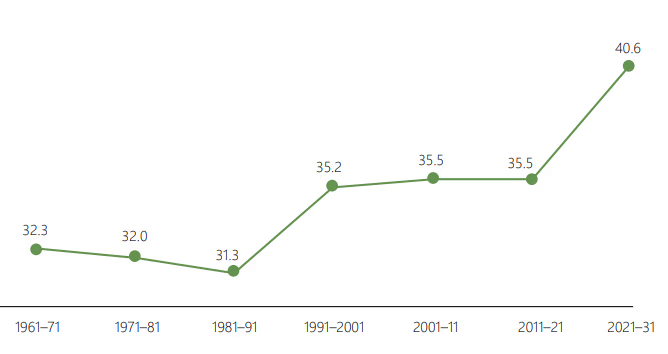
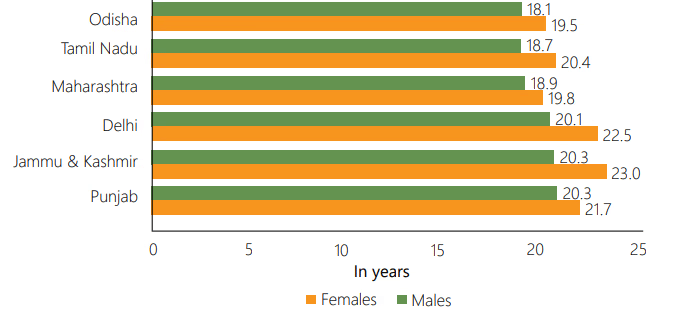
Offshore Sand Mining in Kerala
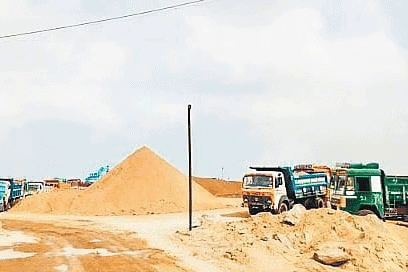 Why in News?
Why in News?
- The Union government's initiative to commence offshore sand mining along Kerala's coast under the Offshore Areas Mineral (Development and Regulation) Amendment Act, 2023 (OAMDR Amendment Act), has faced significant opposition from the state government and local communities. Concerns are primarily focused on the ecological and livelihood impacts of this mining activity.
Key Takeaways
- The Centre's decision is based on a Geological Survey of India (GSI) study identifying substantial construction-grade sand resources off Kerala’s coast.
- Opposition arises due to potential environmental degradation and threats to local livelihoods.
Additional Details
- Economic Potential: The GSI has identified construction-grade sand resources in areas such as Ponnani, Chavakkad, Kochi, Alappuzha, and Kollam, with reserves estimated at 750 million tonnes. This could meet Kerala’s construction needs for the next 25 years, with an annual requirement of 30 million metric tonnes.
- Auction Plan: The government plans to auction sand blocks in five coastal sectors, aiming to generate significant revenue through shipping, trade, and Goods and Services Tax (GST) collections.
- What is Offshore Mining? This involves extracting minerals from the seabed. India has delineated various mineral resources offshore, including construction-grade sand and heavy mineral placers.
- Regulatory Framework: The OAMDR Amendment Act, 2023 amends the 2002 Act governing mineral resources in India’s territorial waters, establishing a transparent auction process and a trust for mining-affected communities.
- Concerns: Environmentalists argue that offshore mining could lead to pollution risks, destabilize marine ecosystems, and threaten local communities' livelihoods.
In summary, while offshore sand mining in Kerala presents economic opportunities, it raises significant environmental and social concerns that must be addressed through careful planning and regulation.
Sustainable Nitrogen Management: FAO
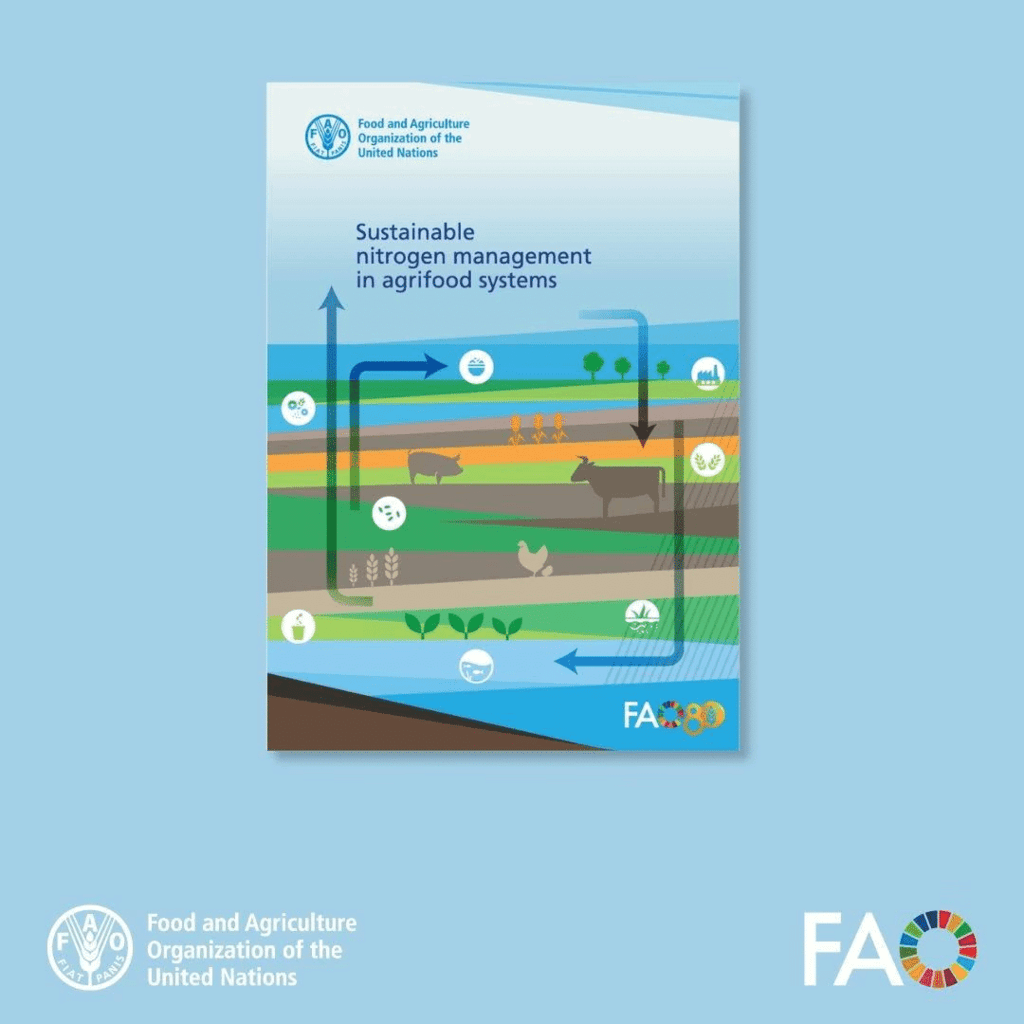 Why in News?
Why in News?
- The Food and Agriculture Organization has published a report titled Sustainable Nitrogen Management in Agrifood Systems, which addresses the pressing issue of nitrogen pollution and its implications for agrifood systems.
Key Takeaways
- Humans add approximately 150 teragrams (Tg) of reactive nitrogen to land annually, potentially increasing to 600 Tg by 2100 due to climate change.
- Livestock is responsible for about one-third of total nitrogen emissions from human activities.
- Global nitrogen flows have exceeded planetary boundaries since 2015.
- Despite a steady rise in global crop yield, Nitrogen Use Efficiency (NUE) has fluctuated.
- Regional disparities in nitrogen management practices affect yield and pollution levels.
Additional Details
- Nitrogen Use Efficiency (NUE): This term describes how effectively a plant utilizes applied or fixed nitrogen for biomass production, calculated as the ratio of nitrogen absorbed to nitrogen applied.
- Poor NUE leads to inefficient nitrogen usage, resulting in significant losses and environmental pollution.
- Nitrogen pollution, characterized by excessive nitrogen compounds, detrimentally impacts air and water quality, human health, and biodiversity.
- Key sources of nitrogen loss include air pollution, greenhouse gas emissions, and water pollution due to nitrate leaching.
- The report proposes interventions such as enhancing fertilizer efficiency, integrating sustainable nitrogen management with climate goals, and promoting a circular bioeconomy.
A comprehensive approach to sustainable nitrogen management is vital to achieving the Sustainable Development Goals by 2030. Addressing nitrogen efficiency can enhance food production, improve health by reducing emissions, and protect water bodies from pollution.
Disputes Related to Indus Water Treaty
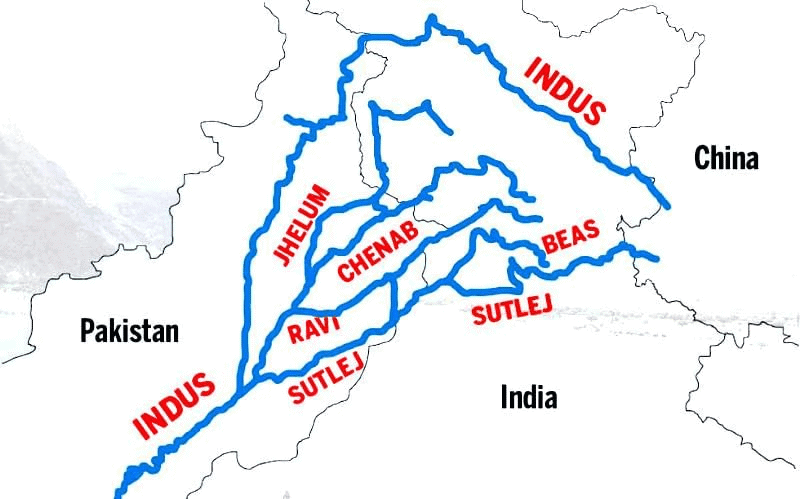 Why in News?
Why in News?
- The Neutral Expert (NE) appointed by the World Bank under the Indus Waters Treaty (IWT) has declared that he is “competent” to adjudicate disputes concerning the Kishenganga and Ratle hydroelectric projects in Jammu and Kashmir (J&K). This decision supports India’s stance to exclude the Permanent Court of Arbitration (PCA), reinforcing its diplomatic and legal efforts to assert rights over the Indus waters.
Key Takeaways
- The NE has affirmed his authority to adjudicate disputes related to the IWT.
- India aims to resolve issues without PCA involvement, focusing on the NE's role.
Additional Details
- Kishanganga Hydroelectric Project: Located on the Kishanganga River (a tributary of Jhelum) in J&K, Pakistan has raised objections, claiming that India's diversion of water for power generation violates the IWT.
- Ratle Hydroelectric Project: This run-of-the-river project on the Chenab River in J&K has faced concerns from Pakistan regarding its design, which allegedly gives India excessive control over river flow.
- Dispute Over Resolution Procedure: Initially, Pakistan requested a NE for the Kishanganga and Ratle projects in 2015 but later pursued adjudication by the PCA, which India opposed, maintaining that the IWT prioritizes the NE over PCA.
- In 2022, the World Bank initiated both NE and PCA processes, with India boycotting the PCA while engaging with the NE, claiming that only the NE has the authority to resolve disputes under the IWT.
What is the Indus Waters Treaty?
- About: The Indus Waters Treaty is a water-sharing agreement between India and Pakistan, signed in 1960 under the aegis of the World Bank. It allocates the waters of the Indus River and its five tributaries (Sutlej, Beas, Ravi, Jhelum, and Chenab) between the two countries.
- Key Provisions:
- Water Sharing Arrangement: The Treaty grants unrestricted use of the three eastern rivers (Sutlej, Beas, Ravi) to India and allocates the three western rivers (Chenab, Jhelum, and Indus) to Pakistan, allowing India limited use for domestic, non-consumptive, agricultural, and hydroelectric purposes.
- Pakistan is allocated roughly 80% of the water from the Indus River system, while India receives approximately 20%.
- Permanent Indus Commission: The treaty established a Permanent Indus Commission (PIC) with representatives from both countries, mandated to meet annually to ensure the treaty's implementation.
- Dispute Resolution Mechanism: Article IX outlines a three-tier dispute resolution process involving initial resolution by the PIC, followed by engagement with a Neutral Expert, and finally, the option to invoke the PCA if necessary.
Why are the Challenges Associated with IWT?
- Outdated Provisions: The IWT does not address modern challenges such as climate change, which has altered hydrological patterns in the Indus basin, affecting water availability.
- Lack of Flexibility: The rigid water allocation limits the ability to implement adaptive water management strategies in response to changing conditions.
- Irregularities of PCA: Ongoing parallel proceedings initiated by the World Bank indicate ambiguities in the treaty's dispute resolution framework, suggesting a need for reform.
- Geopolitical Tensions: The mistrust and hostilities between India and Pakistan complicate cooperation on water-sharing and management.
Way Forward
- Renegotiation of the Treaty: There is an urgent need to revisit the IWT to address its limitations and incorporate provisions for climate resilience and sustainable water management.
- Enhanced Dialogue: India and Pakistan must prioritize dialogue and trust-building measures to resolve disputes amicably, possibly reviving previous dialogues.
- Third-Party Mediation: The World Bank and other neutral parties can facilitate negotiations and ensure compliance with the treaty.
- Focus on Technical Solutions: Both countries should adopt a technical and scientific approach to resolve disputes over hydroelectric projects, emphasizing data sharing and joint studies.
Mains Question:
- What is the Indus Water Treaty (IWT)? Discuss why India wants to renegotiate IWT.
Mitigating and Aggravating Circumstances in Death Penalty
 Why in News?
Why in News?
- A recent ruling from a Kolkata court sentenced a convict to life imprisonment for the rape and murder of a doctor at RG Kar Medical College and Hospital, despite the CBI's strong argument advocating for the death penalty. This case highlights the ongoing discussions surrounding the application of the death penalty in India, especially referencing the landmark Bachan Singh vs. State of Punjab Case from 1980, where the Supreme Court upheld the death penalty as constitutional but specified it should be applied in the "rarest of rare" cases considering both aggravating and mitigating circumstances.
Key Takeaways
- Aggravating circumstances can lead to a death penalty, while mitigating circumstances can sway courts away from it.
- The Supreme Court provided guiding factors but did not specify exact criteria for these circumstances.
Additional Details
- Aggravating and Mitigating Circumstances: These are factors considered by courts when determining the severity of a sentence. Aggravating circumstances may prompt the court to lean towards the death penalty, while mitigating circumstances may suggest a lesser sentence.
- Guiding Factors:The Supreme Court did not list specific circumstances but provided a non-exhaustive list, including factors such as:
- If the murder was premeditated and involved extreme brutality.
- If it showed exceptional depravity.
- Whether the accused murdered a public servant in the line of duty.
- Age of the accused and their mental state at the time of the crime.
- The evolution of these factors has been influenced by various cases, stressing the importance of both the nature of the offence and the potential for reform.
The Supreme Court's approach to the death penalty has evolved to consider both the severity of crimes and the possibility of rehabilitation for offenders, emphasizing fairness in sentencing. The Court has advocated for a balanced evaluation of both aggravating and mitigating factors while ensuring procedural safeguards to prevent arbitrary decisions.
Decline in India’s Total Fertility Rate
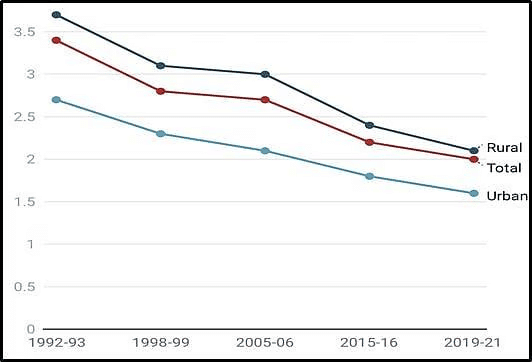 Why in News?
Why in News?
- The Global Burden of Diseases, Injuries, and Risk Factors Study (GBD) 2021 has highlighted a significant decline in India’s Total Fertility Rate (TFR) over the decades. This trend raises concerns regarding potential socio-economic and political implications, particularly in southern states.
Key Takeaways
- India's TFR decreased from 6.18 in the 1950s to 1.9 in 2021, falling below the replacement level of 2.1.
- By 2100, the TFR is projected to further decline to 1.04, indicating an average of less than one child per woman.
- Southern states, such as Kerala, Tamil Nadu, and Karnataka, reached replacement-level fertility before northern states.
Additional Details
- Regional Variations: By 2036, Kerala's population over 60 is expected to exceed the number of children, reaching 23%. This demographic shift is influenced by high literacy rates, women's empowerment, and advancements in social and health sectors.
- Reasons for Fertility Decline: Factors such as female literacy, workforce participation, and changing attitudes towards marriage and motherhood have significantly impacted fertility rates. Additionally, increased infertility cases, social acceptance of abortions, and young people migrating abroad for opportunities also contribute to this decline.
- Consequences of Low Fertility Rates: The aging population is a critical concern, with 149 million individuals aged 60 and above currently, projected to rise to 347 million by 2050. This demographic shift poses economic challenges, including higher dependency ratios and strain on social welfare systems.
In conclusion, India's declining fertility rates present complex socio-economic challenges that require strategic policy responses. Addressing these issues can help mitigate potential consequences and foster a more sustainable demographic structure.
India's Fiscal Consolidation
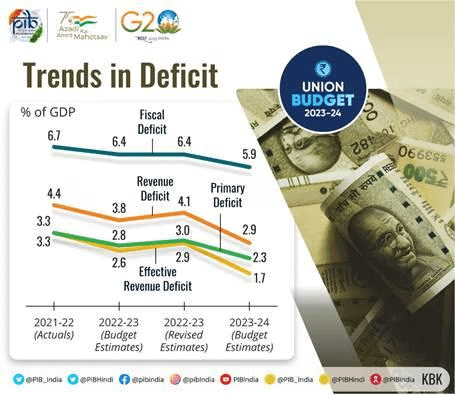 Why in News?
Why in News?
- India has achieved a significant reduction in its fiscal deficit, decreasing from a pandemic high of 9.2% of GDP in FY 2020-21 to an estimated 5.6% in FY 2023-24, with a target of 4.9% for FY 2024-25. This has been accomplished through targeted spending and enhanced revenue collection, demonstrating substantial progress in fiscal consolidation under the Fiscal Responsibility and Budget Management (FRBM) Act, 2003.
Key Takeaways
- Fiscal deficit reduction from 9.2% to 5.6% of GDP.
- Target fiscal deficit of 4.9% for FY 2024-25.
- Progress made through targeted spending and revenue optimization.
Additional Details
- Fiscal Consolidation: It refers to the prudent management of government finances to ensure long-term economic stability. This involves balancing government revenue (taxes and non-tax receipts) with expenditure to minimize fiscal deficits, control public debt, and support sustainable economic growth.
- Key Features:
- Prudent Spending: Focus on essential areas such as infrastructure, health, and education.
- Revenue Optimization: Maximize tax collection, reduce evasion, and broaden the tax base.
- Deficit Control: Limit fiscal deficits to avoid excessive borrowing.
- Debt Management: Ensure public debt remains sustainable to prevent economic crises.
- Accountability: Maintain transparency through audits and compliance with regulations.
- Significance:
- Macro-Economic Stability: Controls inflation and stabilizes currency exchange rates.
- Reduced Debt Burden: Prevents unsustainable borrowing, easing the burden on future generations.
- Investor Confidence: Signals sound economic management, attracting investments.
- Efficient Resource Utilization: Prevents wasteful expenditures, ensuring resources are directed toward development priorities.
Fiscal consolidation plays a crucial role in managing economic stability and growth. Under the FRBM Act, the fiscal deficit decreased from 4.5% of GDP in FY 2013-14 to 3.4% by FY 2018-19, which helped control inflation by curbing excessive government borrowing and spending. The government also increased capital expenditure during the pandemic, raising it from 1.6% of GDP in FY 2014-15 to 3.2% in FY 2023-24, supporting critical infrastructure development.
Furthermore, initiatives such as the digitization of the tax system have led to improved tax collection efficiency, with tax receipts rising from 10% of GDP in FY 2014-15 to 11.8% in FY 2023-24. Structural reforms, including the Production Linked Incentive (PLI) scheme, have also been launched to bolster domestic manufacturing and ensure steady growth amidst global uncertainties.
Challenges in India's Fiscal Consolidation
- Compromising Welfare: There are concerns that an excessive focus on reducing the fiscal deficit may limit essential spending for economic growth and harm public welfare programs.
- Geopolitical Tensions: Changing trade dynamics and increased regulations can affect India's external trade and fiscal health.
- Volatile Capital Flows: Fluctuations in capital flows due to rising interest rates in developed economies can impact fiscal deficits.
- Rising State Deficits: Several states are experiencing rising fiscal deficits, exceeding the recommended 3% of GSDP.
- Sustaining Capital Expenditure: Maintaining a capital expenditure rate of 3.2% without increasing fiscal deficit poses a challenge.
Way Forward
- Tax Reforms and Mobilization: Enhancing the tax base, especially in the informal sector, and improving compliance will be crucial to meet fiscal targets.
- Investment vs. Deficit Control: While controlling fiscal deficits is critical, it is essential to balance this with the need for long-term growth.
- Monetary and Fiscal Coordination: Effective coordination between the Reserve Bank of India and the government is necessary to manage currency market volatility.
In conclusion, while India has made commendable strides in fiscal consolidation, several challenges remain that require targeted reforms and strategic planning to ensure sustainable economic growth.
Strengthening India-Indonesia Ties
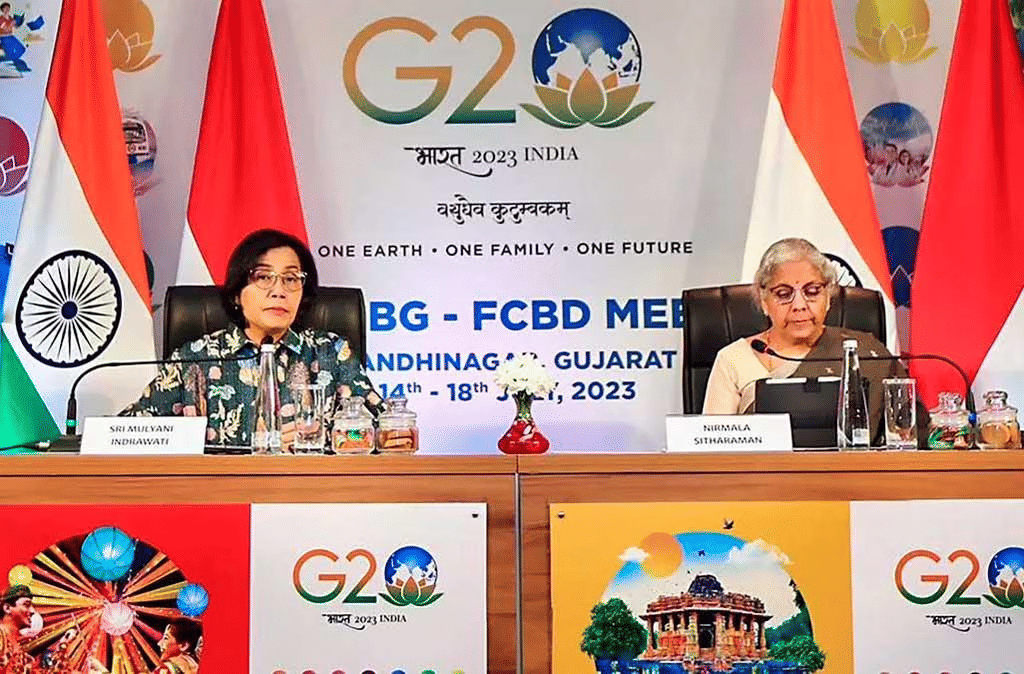 Why in News?
Why in News?
- The President of Indonesia was the Chief Guest at India’s 76th Republic Day celebrations, marking the 75th anniversary of India-Indonesia diplomatic relations. Both countries signed several MoUs covering areas such as health cooperation, digital infrastructure, and defence collaboration.
Key Takeaways
- Comprehensive Strategic Partnership: The bilateral relationship was upgraded to a comprehensive strategic partnership in 2018.
- Defence Cooperation: Initiatives include Coordinated Patrol, Ex Garuda Shakti (Army), Ex Samudra Shakti (Naval), and the establishment of a Bilateral Maritime Dialogue.
- Trade Cooperation: Bilateral trade reached USD 38.8 billion in 2022-2023, with initiatives to resolve trade barriers and expedite the AITIGA review.
Additional Details
- Health and Energy Security: Focus on biofuels and joint exploration of critical minerals like nickel and bauxite. MoUs were signed on health cooperation and traditional medicine quality assurance, emphasizing digital health.
- Technological Cooperation: India offered to share expertise in Digital Public Infrastructure, Quantum Communication, and High-Performance Computing with Indonesia.
- Cultural Cooperation: India aims to assist in restoring the Prambanan Temple in Indonesia and reaffirmed the “Kashi Cultural Pathway” principles from the G20 Culture Ministers' Meeting.
- Multilateral Cooperation: Emphasis on ASEAN centrality and cooperation on regional issues, including the ASEAN Outlook on Indo-Pacific and the Indian Ocean Rim Association (IORA).
Overall, Indonesia plays a vital role in India’s regional strategy, with strong ties in trade, defense, and maritime security. Both countries aim to deepen collaboration through technological, cultural, and multilateral efforts, bolstering their relationship and reinforcing stability in the Indo-Pacific.
How India-Indonesia Ties Evolved Overtime?
- Early Post-Independence Period (1940s-1950s): India supported Indonesia’s independence. They signed a Treaty of Friendship in 1951, focusing on trade, culture, and military cooperation.
- Deterioration in Ties (1960s): Relations strained due to India's ties with China and Indonesia siding with Pakistan during the 1965 India-Pakistan conflict.
- Cold War Era (1966-1980s): Indonesia sought to rebuild ties with India, leading to key agreements like the 1977 maritime boundary pact.
- 'Look East' Policy 1991 (1990s): Trade grew under India's ‘Look East’ policy, evolving a comprehensive partnership.
- Recent Developments (Since 2000s): Indonesia became India’s largest trading partner in ASEAN, with significant trade growth and joint calls for resolving maritime disputes.
Why is Indonesia Significant to India?
- Strategic Importance: Indonesia controls key sea lanes, making it essential for maritime security and trade flow in the Indo-Pacific region.
- Natural Resources: Indonesia's rich resources, including palm oil and critical minerals, offer opportunities for India in energy and agriculture.
- Defense Cooperation: The potential BrahMos missile deal highlights the growing defense ties between the two nations.
- Politics and Governance: Indonesia's secularism and approach to counter-terrorism can provide lessons for India.
- Global Influence: Indonesia's leadership in regional forums strengthens its cooperation with India.
In conclusion, Indonesia is a valuable partner for India, playing a vital role in its regional strategy with strong ties in trade, defense, and maritime security.
Mains Question:
- How has India-Indonesia cooperation evolved over time, and what is Indonesia's strategic importance in India's foreign policy today?
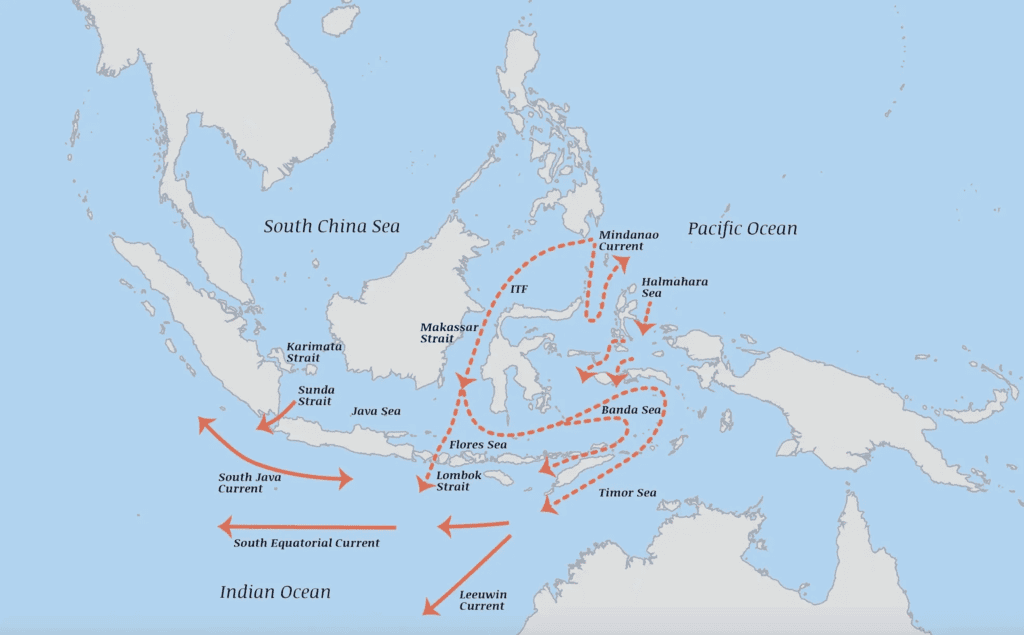
ASER 2024 and Elementary Education
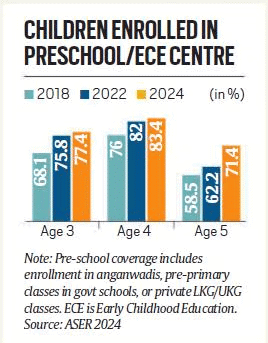 Why in News?
Why in News?
- The NGO Pratham Foundation released the Annual Status of Education Report (ASER) 2024, which evaluates the learning outcomes of school students in rural India. This survey covered 17,997 villages across 605 rural districts, reaching a total of 649,491 children aged 3-16 years, and tested the reading and arithmetic skills of over 500,000 children in the 5-16 years age group.
Key Takeaways
- ASER is a nationwide, citizen-led household survey that provides insights into children's schooling and learning in rural India.
- Enrollment in pre-primary institutions has steadily increased, with significant growth noted among 3-year-olds.
- Overall enrollment at the elementary level saw a slight decline, accompanied by mixed results in reading and arithmetic skills.
- Digital literacy assessments show older children possess notable smartphone skills.
Additional Details
- What is ASER: ASER was launched in 2005 to track educational trends and challenges in rural areas, evolving in focus and coverage.
- Focus Areas:
- Enrollment: Tracks trends in school and preschool enrollment, identifying improvements and challenges by state and age group.
- Learning Outcomes: Assesses children's progress in reading and arithmetic at both primary and secondary levels.
- Digital Literacy: Evaluates older children's skills with smartphones, including tasks like setting alarms and messaging.
- Key Findings:
- Pre-primary enrollment rose for 3-year-olds from 68.1% in 2018 to 77.4% in 2024.
- In elementary education, overall enrollment slightly dropped from 98.4% in 2022 to 98.1% in 2024.
- Improvements in arithmetic skills were noted, with 45.8% of Std VIII students able to solve basic problems.
- Challenges:
- Poor infrastructure across schools, with over 1.52 lakh lacking functional electricity.
- Limited access to technology in government schools compared to private institutions.
- Social divides and language barriers hinder educational access and quality.
In conclusion, the ASER 2024 report highlights both the progress and ongoing challenges within elementary education in India. While there are signs of improvement in enrollment and skill acquisition, significant structural and policy changes are necessary to further strengthen the educational framework.
OECMs for Achieving KMGBF 2022 Targets
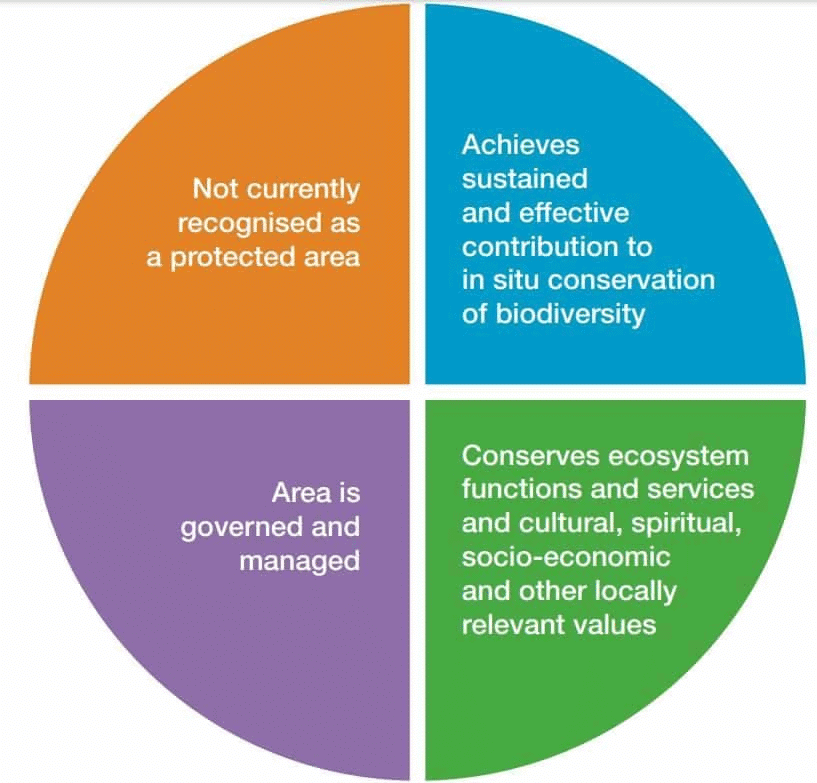 Why in News?
Why in News?
- A new report titled “Guidance on Other Effective Area-based Conservation Measures (OECMs)” has been released by the World Commission on Protected Areas (WCPA) and WWF. The guidelines, which include case studies, focus on conserving land, water, and marine areas to achieve GBF Target 3 of the Kunming-Montreal Global Biodiversity Framework (KMGBF) 2022, aiming to conserve 30% of these areas by 2030.
Key Takeaways
- OECMs are not formal protected areas but support biodiversity conservation.
- Guidelines emphasize sustainable governance and management of these areas.
- Case studies illustrate successful OECM implementations across different regions.
Additional Details
- What are OECMs? OECMs are defined as geographically defined areas that are not designated as protected areas but are governed to achieve positive, sustained, long-term outcomes for the in situ conservation of biodiversity. Examples include agricultural lands and forests managed for timber.
- Criteria for Identifying OECMs: OECMs must not be formal protected areas, should demonstrate governance flexibility, have multiple conservation objectives, ensure sustained conservation, and their identification should be voluntary.
- Significance: OECMs acknowledge vital sites for biodiversity that aren’t formally protected, thereby expanding the global network of conserved areas and enhancing biodiversity coverage.
Case Studies
- Los Amigos Conservation Area: Located in the Los Amigos watershed, Peru; supports 12 globally threatened species, 12 primate species, and over 550 bird species.
- Wits Rural Facility: Situated in South Africa with a focus on maintaining intact savannah and river habitats.
- North Tyndal Protected Water Area: Located in Nova Scotia, Canada; aimed at biodiversity conservation through the maintenance of native vegetation and prohibition of harmful land uses.
Difference Between OECMs and PAs
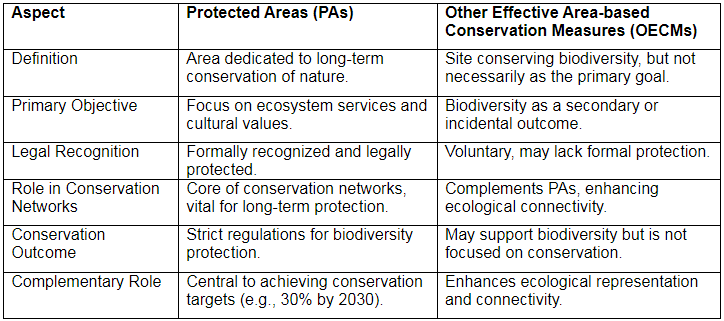
What are Eight Sections Containing Guidelines for OECMs?
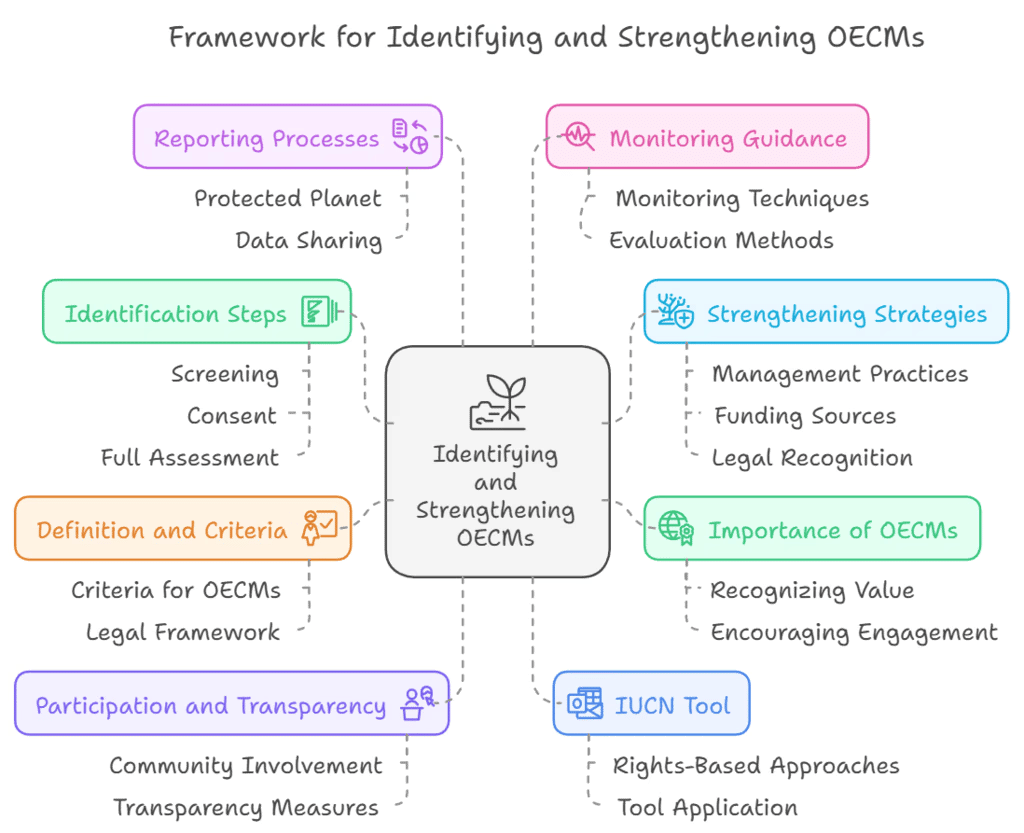
What is KMGBF 2022?
About: Adopted at CoP 15 (Montreal, Canada) in December 2022, it aims to halt and reverse global biodiversity loss by 2030. It supports the Sustainable Development Goals (SDGs) and builds upon the achievements and lessons learned from the Strategic Plan for Biodiversity 2011–2020.
- Objectives: Includes 23 action-oriented global targets for urgent action by 2030, aiming to restore at least 30% of degraded terrestrial, inland water, and marine ecosystems.
- Future Outlook: Envisions a collective commitment to live in harmony with nature by 2050, guiding current actions and policies on biodiversity conservation and sustainable use.
What is India’s Biodiversity Target Under KMGBF?
- Conservation Areas: Aim to enhance biodiversity through the conservation of areas.
- Invasive Species: Target a 50% reduction in invasive alien species.
- Rights and Participation: Ensure the involvement of indigenous peoples, local communities, women, and youth in conservation efforts.
- Sustainable Consumption: Promote sustainable consumption and halve food waste.
- Benefit Sharing: Encourage fair sharing of benefits from genetic resources and traditional knowledge.
- Pollution Reduction: Aim to reduce pollution, halving nutrient loss and pesticide risk.
- Biodiversity Planning: Manage areas to prevent the loss of high biodiversity regions.
In conclusion, the guidelines released by the IUCN and WWF under the Kunming-Montreal Global Biodiversity Framework highlight the importance of conserving 30% of land, waters, and marine areas by 2030. India’s biodiversity targets align with global goals to enhance conservation, reduce invasive species, and promote sustainable consumption.
Mains Question:
- What are Other Effective Area-based Conservation Measures (OECMs)? How are they different from Protected Areas?
Crosspathy
Why in News?
- In December 2024, the Maharashtra Food and Drugs Administration (FDA) issued a directive allowing homeopathic practitioners with a pharmacology certificate to prescribe allopathic medicines. This decision has faced criticism from the Indian Medical Association (IMA), which warns it could lead to "crosspathy" and harm patients.
Key Takeaways
- Crosspathy involves practitioners of alternative medicine prescribing or treating patients with allopathic medicines.
- The practice raises significant concerns regarding patient safety and the quality of care provided.
- Legal precedents highlight the risks associated with cross-system practices in healthcare.
Additional Details
- What is Crosspathy: Crosspathy refers to healthcare professionals practicing outside their recognized scope of expertise, specifically alternative medicine practitioners administering treatments meant for allopathic (modern) medicine.
- Concerns: This practice can lead to misdiagnosis, inappropriate treatments, and increased risks to patient safety, as practitioners may lack adequate training in modern medical methods.
- Regulations and Legal Precedents: The Medical Council of India (MCI) Code of Ethics 2002 restricts unqualified individuals from conducting medical procedures. A pivotal Supreme Court ruling in 1996 held a homeopath liable for negligence after prescribing allopathic medicines, establishing that cross-system practice can constitute medical negligence.
- Reasons for Promoting Crosspathy: The shortage of specialists in rural areas and the need to improve healthcare access are often cited as reasons to promote the integration of AYUSH practitioners into allopathic roles.
- IMA's Concerns: The IMA argues that allowing this practice undermines medical qualifications and could compromise patient safety, as AYUSH practitioners lack formal training in modern medicine.
In conclusion, while the push for crosspathy may stem from genuine healthcare access concerns, it poses serious risks that need to be addressed through proper regulatory frameworks and training to ensure patient safety and uphold the integrity of medical practices.
State of the Economy

Why in News?
- The Finance Minister, Nirmala Sitharaman, presented the Economic Survey in Parliament, outlining a roadmap for reforms and growth, which sets the stage for the Union Budget 2025.
Key Takeaways
- The global economy in 2024 is projected to grow at a rate of 3.2%, with uneven growth patterns.
- India's GDP is expected to grow between 6.3% and 6.8% in FY26, driven by agriculture and services.
- Sector-wise, agriculture is projected to grow by 3.8%, while the services sector is the fastest-growing at 7.2%.
- India remains the top global recipient of remittances, which helps in managing the current account deficit.
Additional Details
- Global Economy: The International Monetary Fund (IMF) has indicated moderate growth, with manufacturing facing challenges due to supply chain issues, while the services sector remains robust.
- Inflation: Global inflation has eased, but services inflation is persistent, prompting varied monetary policies among central banks.
- Challenges Facing India: Geopolitical uncertainties, such as the Russia-Ukraine war and the Israel-Hamas conflict, have affected trade and energy security, leading to increased freight costs.
- Investment is pressured by weak global manufacturing demand, which in turn affects private sector investment and overall economic growth.
- Financial Risks: Rising state fiscal stress due to increased subsidies and lower tax revenues is a growing concern.
In summary, despite the challenges posed by global uncertainties and inflationary pressures, India's economic outlook remains positive due to domestic resilience and ongoing structural reforms. However, proactive measures are necessary to mitigate risks and sustain growth.
|
164 videos|800 docs|1156 tests
|
FAQs on Weekly Current Affairs (22nd to 31st January 2025) - General Test Preparation for CUET UG - CUET Commerce
| 1. What are the main challenges posed by an aging population in India? |  |
| 2. How does offshore sand mining impact the environment in Kerala? |  |
| 3. What are the key objectives of the FAO's Sustainable Nitrogen Management initiative? |  |
| 4. What are the primary issues surrounding the Indus Water Treaty disputes? |  |
| 5. What factors have contributed to the decline in India’s total fertility rate? |  |
















